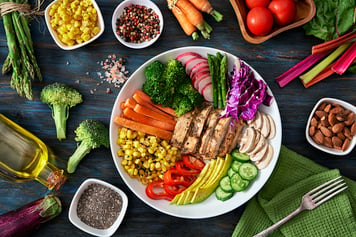While there isn’t a specific measurement or number to look out for, a food is considered nutrient dense when it packs a lot of healthy nutrients (healthy fats, fiber, vitamins, minerals, antioxidants) in a small package. Think blueberries or chia seeds!
For a diet to be nutrient dense, the majority of the foods eaten have to have some type of health-promoting quality. An example would be the Mediterranean Diet. It's packed with fresh fruits and vegetables, healthy fats from fish and oils and low in processed foods and red meat.
About the healthy nutrients.
When you're at the grocery store, take a look at the food label. You'll want to look for higher numbers of monounsaturated and polyunsaturated fats (instead of high amounts of saturated or trans fats), dietary fiber, and many vitamins and minerals under the protein.
.png?width=1140&height=641&name=Blog%20Graphics%20(1).png)
Adding more nutrient-dense food to your diet.
A 'majority' can indicate about 80% - that means that around this much of your diet includes the following examples of nutrient dense foods/food groups. It is important to get a variety of each, which means different colors of produce and different sources of protein.
- Fruits: Fresh and frozen are ideal, then opt for canned in water or their own juice. Fruit juice still contains some vitamins but lacks fiber.
- Vegetables: Opt for fresh and frozen and in their whole form rather than juice.
- Nuts and Seeds: These are packed to the brim with healthy fats, fiber, a splash of protein, vitamins and minerals, and antioxidants. Just a small handful packs a huge nutrition punch.
- Minimally Processed Protein: Fish like salmon, tuna, and mackerel; chicken and turkey, fresh cuts of beef, pork, lamb and deer. Opt for animals that live and die in humane conditions and eat healthier diets (think free-range, antibiotic/hormone-free, wild caught, grass-fed, and Kosher/Halal which indicates humanely slaughtered), as they promote
much less inflammation than their processed counterparts with a lower quality of life (it makes a difference!). - Beans and Lentils: These are high in fiber, protein, and minerals, plus inexpensive and versatile. Edamame is an often-overlooked nutritional powerhouse that falls into this family, as well.
- Bonus Foods: Tea and coffee, dark chocolate with 4 or fewer ingredients, oils (olive, avocado, coconut, sesame, safflower), and spices and herbs (as varied as possible), and high-nutrient whole grains (oats, barley, quinoa, wild rice, buckwheat, bulgur, spelt).
Sources: Healthline.com, Harvard Health
Care you will love
Table of contents


.jpg?width=356&height=261&name=iStock-1433432507%20(2).jpg)
